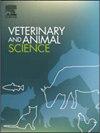犊牛发酵剂中不同脂肪来源及其对犊牛生长性能、血液指标和免疫系统的影响
IF 1.9
Q2 AGRICULTURE, DAIRY & ANIMAL SCIENCE
引用次数: 0
摘要
小牛从出生到断奶是奶牛养殖的关键和敏感时期,因为它决定了牛群的未来。本研究旨在探讨不同脂肪来源对哺乳犊牛生长性能、免疫反应及瘤胃和血液参数的影响。选取40头平均体重40 kg、体分3的荷斯坦母犊牛,从出生至断奶(3 ~ 75 d)进行研究。采用完全随机设计,共4个处理(每个10个重复):i)对照(无脂肪源),ii)椰子油(2%饱和脂肪),iii)亚麻籽油(2%亚油酸),iv)红花油(2%亚油酸)。每周评估犊牛生产性能,每天检查粪便。在试验结束时评估瘤胃参数(挥发性脂肪酸和pH)、血液参数(葡萄糖、蛋白质、尿素和胆固醇)和免疫反应(白细胞、红细胞和免疫球蛋白G)。结果表明,红花油处理10周采食量最高,与对照处理差异显著(p <;0.05)。添加不饱和脂肪的犊牛增重在第8、9和10周达到最高,显著高于对照组和添加椰子油的犊牛(p <;0.05)。除第1周和第2周外,脂肪对犊牛身高均有影响。各试验组在整个试验期内粪便评分无显著差异(p >;0.05)。试验期间各处理对犊牛瘤胃液pH的影响不显著。处理对总挥发性脂肪酸含量有显著影响(p <;0.01)。犊牛的血液参数(葡萄糖、蛋白质和尿素)、红细胞和免疫球蛋白G均受到显著影响(p <;0.05)。本研究结果表明,犊牛起始日粮中使用不同脂肪来源,特别是含有亚油酸和亚麻酸的不饱和脂肪酸,与其他组相比,提高了母荷斯坦犊牛的生长性能、免疫反应和瘤胃/血液参数。本文章由计算机程序翻译,如有差异,请以英文原文为准。
Different sources of fat in starter and its effect on growth performance, blood parameters and immune system of calves
Calf rearing from birth to weaning is a critical and sensitive period in dairy farming, as it determines the future of a herd. The aim of this work was to investigate the effects of different fat sources on growth performance, immune response and rumen and blood parameters in suckling calves. Forty female Holstein calves (average weight 40 kg, body score 3) were studied from birth to weaning (3 to 75 days). A completely randomized design with 4 treatments (10 replicates each) was used: i) control (no fat source), ii) coconut oil (2 % saturated fat), iii) flaxseed oil (2 % linoleic acid), and iv) safflower oil (2 % linoleic acid). Calf performance was evaluated weekly and feces were examined daily. Rumen parameters (volatile fatty acids and pH), blood parameters (glucose, protein, urea and cholesterol) and immune response (white and red blood cells and immunoglobulin G) were assessed at the end of the trial. According to the results, the highest feed intake after 10 weeks was recorded in the safflower oil treatment, which differed significantly from the control treatment (p < 0.05). The highest weight gain of calves fed diets containing unsaturated fats was observed in the 8th, 9th and 10th weeks, which was significantly higher than in the control and treatment containing coconut oil (p < 0.05). The height of experimental calves was affected by fats, except in the 1st and 2nd weeks. The experimental treatments were not significantly different in terms of fecal scores during the entire experimental period (p > 0.05). The effect of the experimental treatments was not significantly dependent on the pH of the calves' rumen fluid during the experimental period. The total volatile fatty acid content was significantly affected by the treatment (p < 0.01) at the end of the experimental period. Blood parameters (glucose, protein and urea), red blood cells and immunoglobulin G of the calves were significantly affected by the treatment (p < 0.05). The results of this study show that the use of different fat sources, especially those with unsaturated fatty acids containing linoleic and linolenic acid, in the starter diet of calves improved growth performance, immune response and rumen/blood parameters in female Holstein calves compared to the other groups.
求助全文
通过发布文献求助,成功后即可免费获取论文全文。
去求助
来源期刊

Veterinary and Animal Science
Veterinary-Veterinary (all)
CiteScore
3.50
自引率
0.00%
发文量
43
审稿时长
47 days
 求助内容:
求助内容: 应助结果提醒方式:
应助结果提醒方式:


